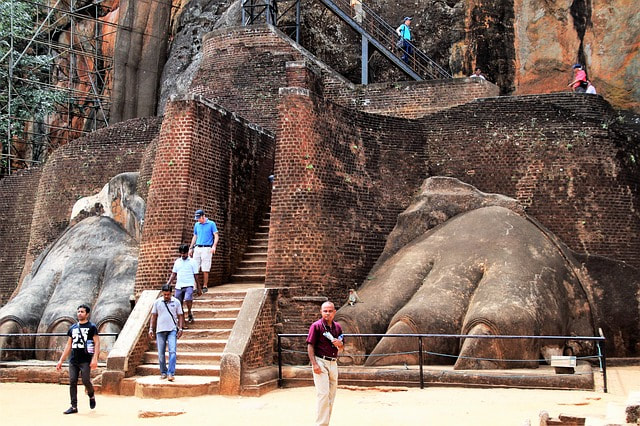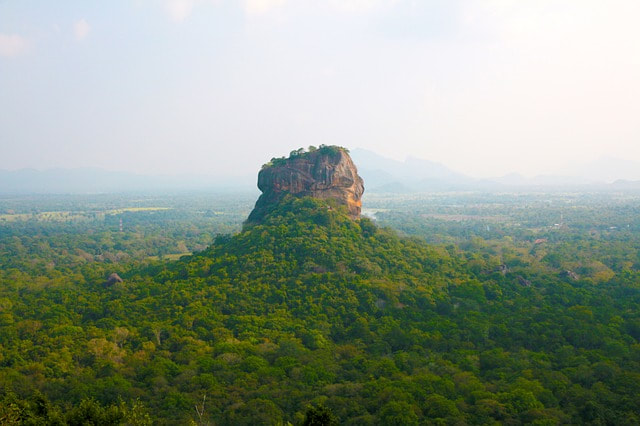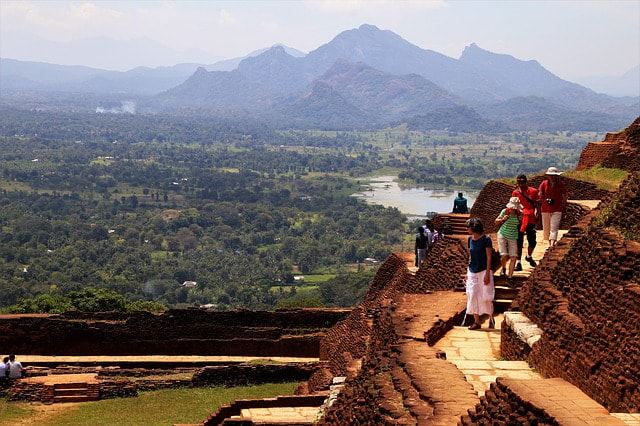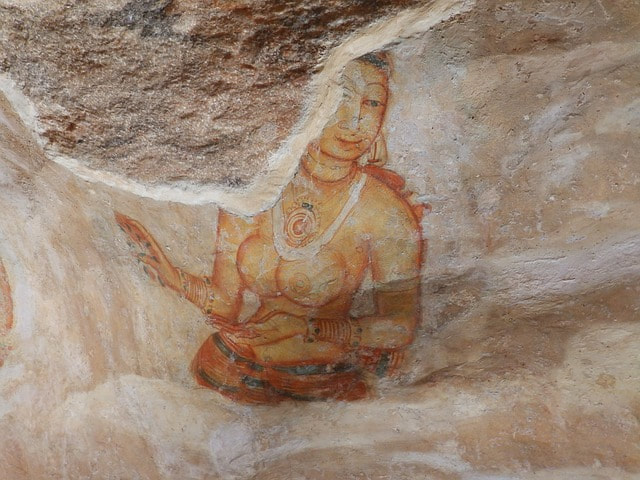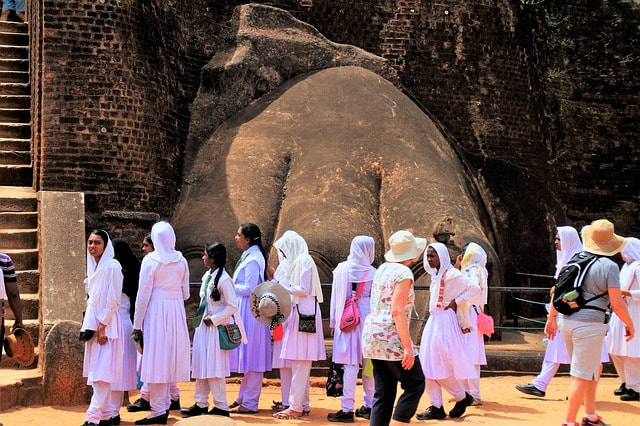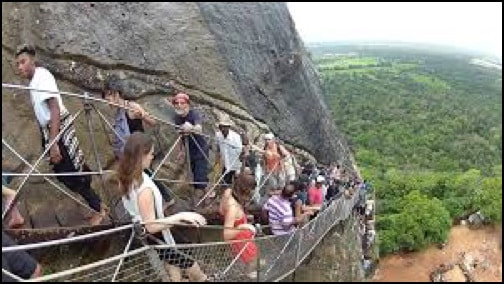The Lion Rock Is a Long Climb, But Well Worth It!
|
By BRIAN WILSON
UK Travel Correspondent Special to North Palm Beach Life There are so many sights that you must see in Sri Lanka – that Pearl in the Indian Ocean - but one must be Sigiriya or the Lion Rock. It is impossible to describe the stupendous site of Sigiriya – you can see it for miles around as it rises 600 feet above the green jungle and rice paddy fields. Just bear in mind that this rock was taken over by King Kasyapa in 477AD who had just killed his father and wanted a secure place to defend as he expected an attack and he chose Sigiriya that had been used by Buddhist monks for hundreds of years before. The citadel was a "palace in the clouds," was in use for a 1,000 years until "rediscovered" by the British in the mid-19th century and it has been a UNESCO site since 1982. First of all – where is it? In the heart of the centre of Sri Lanka. Nothing can really get you ready for your visit – there is a monumentous climb up stone steps, up and down a spiral staircase, then up a wood and metal staircase that is attached (we hope!!) to the face of this enormous rock. If you are not really mobile, or have attacks of vertigo, then the climb may not be for you – but still go there to get a lasting impression of this outstanding UNESCO site.  Mo and our guide Mo and our guide
By the way, we had a guide and he was indispensable. He was a font of knowledge including the history of the rock - he was our driver, so thanks to the Tour Organiser Aitken Spence (see information at the end).
You arrive at the Western entrance to find the Royal Water Gardens. These were not only made to impress, but they told visitors of the King’s riches - for water is the prize, so rice can be harvested twice a year. What you see now are landscaped gardens with water, boulder and terraced gardens fed by a constant flow of water into brick-lined pools and the remains of pavilions. Like us, you’ll stop to wonder and take photos, but you can never forget the edifice of Sigiriya rock that looms over you. Just stop and think how impressive these gardens were as they were the processional way to the Rock . Well you have come all this way – so you cannot help but want to scale this enormous rock. However, if you have mobility problems, or the thought of a 600-foot climb up rickety steps puts you off, then just stay at the bottom and let the others go forth, but make sure you bring plenty of water and try not to start your ascent in the heat of the day, especially when the sun is beating down!! We visited the rock on a public holiday and the whole area was full of families climbing up – including people who were well over 60. Onwards we went with our guide. Taking a detour, at 330 feet, to see the frescoes. Once there were 500, now only 21 remain. Just think about it : When England was struggling with the demise of the Roman Empire and fighting off invaders, the Sri Lanka civilisation had cut out the steps and painted these beautiful images of maidens in a very naturalistic style. The artists used local ingredients to make their colours and painted them on wet plaster, so that, when it dried, the paint became incorporated into the plaster (tempera) – move over Michelangelo !! After a long climb, you’ll reach the Lion Platform on the North Side of the Rock - a good time to get your breath back and have another drink. Now look at the rock and you’ll see the Lion’s claw entrance. As you can see from the photo, all that is left (and what’s left is very impressive) are two giant claws or feet at the entrance to the last part of your climb. At one time a colossal brick lion guarded the final stairway to the summit – use your imagination to look back 1,500 years and try to imagine what it would look like: Just an edifice and the effect of wonder it would have on any visitor or attacker. To make it even more impressive, the original brick design required you to take the stairs that went into the mouth of the Lion.
So, you’ve reached the summit (all 3 acres of it). What is before you is the outline of a series of buildings with outstanding views of the surrounding countryside – to say nothing of the views over the water gardens – look and see how perfect the layout and all some 2,500 years ago. Look and see how rainwater was collected in a series of channels running by the colonnaded Royal Summer House towards bathing pools that doubled as a reservoir. There are the remains of the Royal Rock Throne where the King would receive visitors in all the splendour that could be brought together. To say that all this is impressive is an understatement. Just look how the walls are built from massive rocks with no cement (all happening at a similar time to the Mayan Civilisation). Look and see how the rocks of the reservoir and other buildings have been cut in a straight line – all this using stone tools!! All that is left is to climb back down again!! But wait – the tour has not ended for, at the base of the rock you’ll find some of the caves used by Buddhist monks even before the king took over the rock. Some caves have the vestiges of rock paintings or were where statues of Buddha could be found. The problem with Sri Lanka is that there are so many fantastic sights to visit, it may be a long journey but, believe me, it is certainly worth it. My wife, Mo (short for Maureen) and I visited Sri Lanka on a tour provided by Aitken Spence (Colombo Office 4th floor, Aitken Spence Tower 2, 315 Vauxhall Street. Email [email protected] |
List of All 'Life in the UK' ArticlesThe citadel was a "palace in the clouds," in use for a 1,000 years until "rediscovered" by the British in the mid-19th century and it has been a UNESCO site since 1982.
If you have mobility problems, or the thought of a 600-foot climb up rickety steps puts you off, then just stay at the bottom and let the others go forth.
The artists used local ingredients to make their colours and painted them on wet plaster, so that, when it dried, the paint became incorporated into the plaster (tempera) – move over Michelangelo !!
At one time a colossal brick lion guarded the final stairway to the summit – use your imagination to look back 1,500 years and try to imagine what it would look like.
All that is left is to climb back down again!!
|
